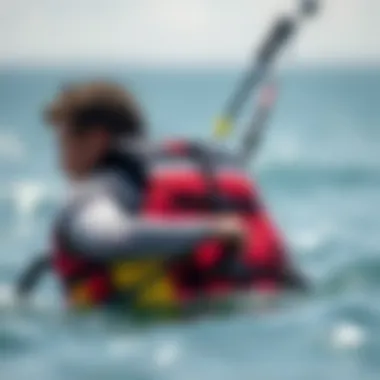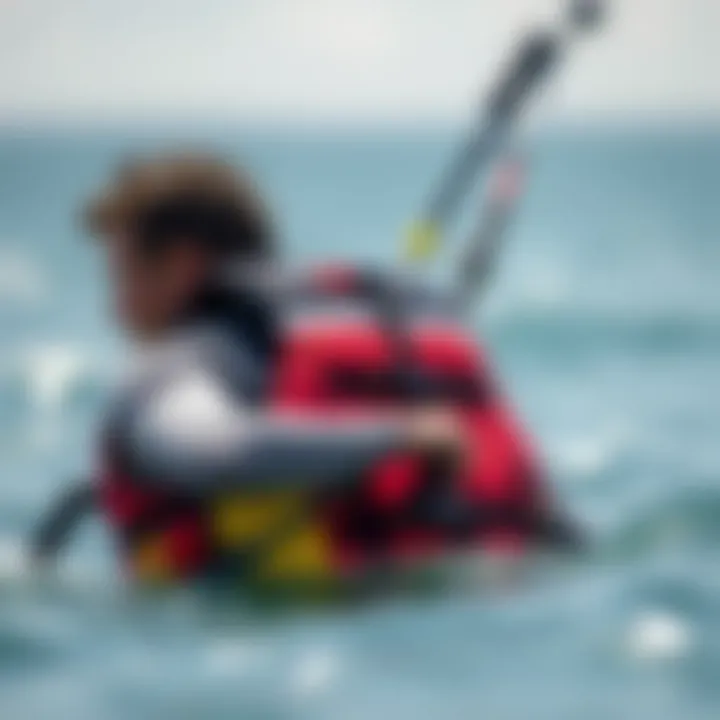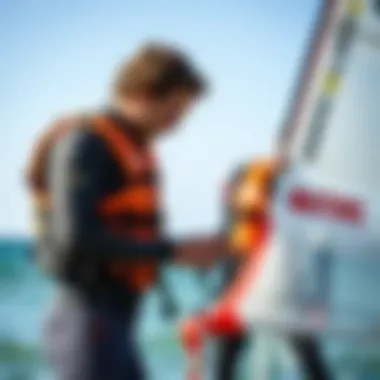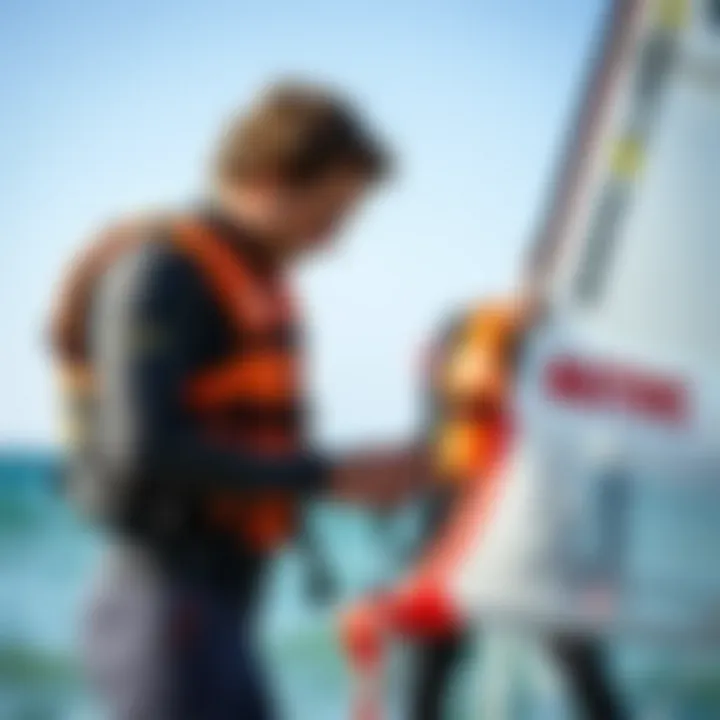The Importance of Windsurfing Life Jackets for Safety


Intro
Windsurfing, while exhilarating, isn’t without its own set of risks. As with all water sports, safety gear plays a crucial role in ensuring that your adventures don’t turn into misadventures. Among all the equipment that a windsurfer needs, a life jacket—often dubbed a Personal Flotation Device (PFD)—is arguably the most essential. It's not just about meeting regulations; it's about safeguarding your life.
This article dives into the vital role that life jackets play in windsurfing, offering a comprehensive guide that encompasses various aspects. From understanding the types of jackets available to important considerations for choosing the right one, we aim to unravel every facet of this crucial gear. Moreover, we will clarify some common misconceptions around buoyancy aids versus true life jackets, bolster awareness of the regulations surrounding their use, and provide maintenance tips to prolong their lifespan. By the end, you should have a solid grasp of how to make informed choices in the realm of windsurfing safety gear—ensuring that your time on the water is not just fun, but also secure.
Prolusion to Windsurfing Safety
Navigating the dynamic world of windsurfing is not just about mastering the techniques or riding the waves; it significantly revolves around safety. Safety in watersports, particularly windsurfing, cannot be overstated. Windsurfing is inherently thrilling, but the unpredictable nature of water and wind plays a crucial role in every session on the water. Understanding the elements of safety ensures that windsurfers can make the most of their experience while mitigating risks.
The Importance of Safety in Watersports
The essence of safety lies in preparation and awareness. Just like a car needs brakes to prevent accidents, windsurfers need to understand the importance of safety gear, especially life jackets. Engaging in watersports without adequate safety measures invites unnecessary dangers that may compromise not only personal safety but also the enjoyment of the sport.
Why is safety so critical? Here are a few key aspects:
- Risk Mitigation: Windsurfers are often exposed to varying weather conditions. Strong winds and choppy waters can quickly transform from a delightful ride to a perilous situation. Adequate safety gear can drastically reduce the risk of accidents.
- Increased Confidence: Knowing that you’re equipped with the right safety equipment empowers you to push your limits without diving headfirst into danger.
- Emergency Response: In the unfortunate event of an accident, being prepared with proper safety gear, including life jackets, can save lives. A life jacket provides essential buoyancy, allowing for quicker recovery from falls or capsizes.
- Education and Awareness: Safety practices foster a culture of awareness among communities of windsurfers. Educated individuals can pass on their knowledge and encourage more people to take safety seriously.
A Focus on Life Jackets
Focusing on life jackets specifically, it’s essential to realize they are not just an accessory; they are a vital component of windsurfing safety. Life jackets have been the silent heroes in many water adventures. They serve to keep a person afloat, yet their roles extend further.
The design and technology behind modern life jackets cater specifically to the needs of windsurfers. Most importantly, they don’t hinder movement. This is paramount for windsurfing, where full range of motion is needed to control the sail and board. Moreover, the variety of designs on the market caters to different body types, skill levels, and personal preferences. Consequently, everyone can find a suitable life jacket that meets their needs without sacrificing comfort or performance.
Ultimately, incorporating safety measures and selecting the right life jacket is not merely a matter of compliance; it’s about enhancing the overall windsurfing experience. A well-informed approach to safety can make thrilling water adventures not just lively but also safe, ensuring that every ride on the waves is memorable for the right reasons.
Types of Life Jackets for Windsurfing
When getting into windsurfing, one often thinks about the thrill of gliding over water and catching the perfect breeze. However, there's a crucial side to the sport that can’t be overlooked—the type of life jacket one wears. This section dives into the various types of life jackets available for windsurfing, emphasizing their individual characteristics and the significance of choosing the right one.
Personal Floatation Devices Explained
Personal Floatation Devices, commonly referred to as PFDs, are key players when it comes to safety on the water. They come in different styles, each tailored for specific activities and types of water conditions. In windsurfing, a PFD provides essential buoyancy, meaning it keeps a person afloat if they find themselves in the drink.
These devices are categorized into various types based on their flotation capabilities. Here’s a brief breakdown:
- Type I: These are designed for rough waters, offering significant buoyancy. Great for offshore activities, they're the "workhorses" of life jackets.
- Type II: Ideal for calm waters, many windsurfers prefer this style for its lightweight feel and ease of movement on the board.
- Type III: Often seen in recreational settings, these jackets allow for mobility and are typically the most comfortable.
Understanding the characteristics of each PFD can greatly impact safety and performance while windsurfing. Choose wisely.
Buoyancy Aids: A Misunderstood Alternative
Buoyancy aids are often confused with traditional life jackets and might be misunderstood by newcomers to windsurfing. Unlike life jackets that are specifically designed to keep someone afloat in various scenarios, buoyancy aids are more about providing support while allowing for greater range of motion.
These aids are particularly popular among experienced windsurfers who want a jacket that won’t hinder their movements when catching those crisp waves.
| Pros of Buoyancy Aids | Cons of Buoyancy Aids | | Lightweight and flexible | Less buoyancy than PFD | | Greater mobility | Not ideal for all conditions | | Lower profile | May need supplemental flotation |
Despite some drawbacks, buoyancy aids can be a fantastic option for the right conditions. Sometimes, less is more.


Inflatable vs. Non-Inflatable Life Jackets
When it comes to life jackets, windsurfers often face a choice between inflatable and non-inflatable jackets. Understanding the pros and cons is essential in making an informed decision.
Inflatable life jackets deploy upon entering water, providing buoyancy just when needed. They’re typically lightweight and compact, an attractive feature for those keen on portability. However, one must weigh their durability against the potential risk of deflation.
On the other hand, non-inflatable life jackets come ready to go, offering consistent buoyancy without the risk of air loss. They can be bulkier but usually offer reliable, immediate safety.
Consider these points before choosing:
- Inflatable Life Jackets: Lightweight, compact, but can fail if not properly maintained.
- Non-Inflatable Life Jackets: Reliable buoyancy at all times, but often bulkier and less flexible.
In the end, the choice might hinge on personal preference, water conditions, and the level of activity one engages in while windsurfing.
Choosing the right life jacket is fundamental to enjoying the sport and ensuring personal safety. Each type presents its unique advantages and considerations which, when understood well, can enhance the windsurfing experience.
Technical Specifications of Life Jackets
When it comes to windsurfing, life jackets stand as a critical line of defense against the unpredictability of water. The technical specifications of life jackets play a significant role in ensuring safety on the water. Understanding the specific elements, benefits, and considerations regarding these technical aspects can enhance your experience and, most importantly, your safety.
Understanding Buoyancy Ratings
Buoyancy ratings indicate how much weight a life jacket can support. The typical buoyancy rating is expressed in Newtons, where a higher number corresponds to greater support. For instance, a life jacket with a buoyancy rating of 70N is generally designed for users who weigh between 42.5 and 50 kilograms, providing adequate support in various water conditions.
When selecting a life jacket, it’s crucial to match your buoyancy needs with your skill level and intended activities. For novices, a higher buoyancy rating might afford them more confidence, while seasoned windsurfers might prefer a jacket with lower buoyancy for increased mobility. Ultimately, the right buoyancy keeps you afloat, thus giving you a fighting chance in emergency situations.
"Buoyancy is not just about staying above water; it's about maintaining composure in potentially daunting circumstances."
Materials and Construction Quality
The materials and construction quality of a life jacket are crucial factors that should not be overlooked. Fabrics like nylon and polyester tend to be common choices due to their durability and resistance to wear and tear.
- Nylon is often praised for its lightweight properties, making it a popular option for those looking to maintain agility while windsurfing.
- Polyester, on the other hand, is favored for its UV resistance and capacity to withstand prolonged exposure to sunlight, thus preventing degradation over time.
Furthermore, construction methods such as stitching and sealing can directly impact a life jacket's longevity and reliability. Jackets stitched with reinforced seams can often handle rough conditions much better than their counterparts with single-stitched seams. Pay attention to floatation foam as well, since high-quality foams, such as PVC or PE, deliver better performance in terms of buoyancy and comfort.
Sizing and Fit: The Key to Comfort
A good fit is essential for both performance and safety in windsurfing life jackets.
- Correct Sizing: A life jacket should fit snugly but not restrict movement. A loose jacket may come off during a fall, while one that’s too tight can lead to discomfort.
- Adjustable Straps: Many modern jackets come with adjustable straps to help achieve that perfect fit. It’s worth taking the time to adjust these straps before hitting the water.
- Body Type Considerations: Personal body type should also factored in. Different brands often have varying fits, so trying them on can help you get a sense of which design suits you best.
Regulations and Recommendations
Windsurfing isn’t just about catching the perfect wave; it also involves keeping safety at the forefront. Regulations and recommendations concerning life jacket use are not only crucial for preventing accidents but also for ensuring that windsurfers, both seasoned and novices alike, can enjoy their time on the water. Ignoring these guidelines can lead to dangerous situations that put individuals and those around them at risk.
Understanding life jacket regulations can mean the difference between a safe windsurfing experience or a tragedy waiting to happen. Regulatory agencies often establish these guidelines through research and risk assessment, creating a structured environment to support safety while on the water.
Local Laws Governing Life Jacket Use
Not every place is created equal when it comes to windsurfing. Different regions have their own rules governing life jackets, and being aware of these local laws is imperative for anyone looking to hit the waves. For instance, some coastal areas might require all windsurfers to wear a jacket, while others may only mandate it for beginners or minors.


- Check State Regulations: In the United States, each state sets its standards. For example, California has stricter requirements compared to Florida, which may just recommend life jackets.
- Consider Launch Area Rules: Some beaches or lakes may request specific life jackets; those temporary requirements can often catch users off guard.
It’s also worth noting that some localities might have exemptions. For example, if you are windsurfing in specific conditions where professional instructors supervise, you might not need to wear one. Always do your homework before you head out—and never assume that what might apply elsewhere will hold true in your chosen spot.
Safety Standards for Windsurfing Gear
When it comes to gear, safety standards are crafted to protect windsurfers from poorly constructed equipment that could fail when needed most. Understanding the gear’s standards can help surfers choose quality life jackets tailored for their windsurfing adventures.
The most prominent safety standards come from organizations like:
- Underwriters Laboratories (UL): This organization tests and certifies life jackets, monitoring the buoyancy and durability of the gear.
- American National Standards Institute (ANSI): They set expectations for manufacturing processes and operational safety.
In addition, the National Marine Manufacturers Association (NMMA) may also provide guidelines that apply specifically to water sports equipment. Knowing that your life jacket adheres to these organizations' safety measures adds another layer of security.
"Always inspect your life jacket before use. A well-regarded brand won’t protect you from a ripped or worn-out jacket."
When selecting life jackets, look for labels that indicate they meet safety standards. Certain certifications may even specify that they are particularly suited for high-impact activities like windsurfing.
In summary, being well-informed about regulations and recommendations provides an edge when it comes to safety in windsurfing. Life jackets not only save lives, but they also ensure that individuals can enjoy the sport with peace of mind, making the experience all the more enjoyable.
Choosing the Right Life Jacket
Selecting the appropriate life jacket is crucial for any windsurfing enthusiast. The right life jacket not only enhances safety but also offers comfort and freedom of movement. With various styles, types, and features available, understanding your personal needs and skill level is essential in making an informed choice.
Assessing Personal Needs and Skills
Before diving headfirst into the sea of options, it’s key to consider individual factors. Each windsurfer is different, and what suits one may not suit another. Here’s a checklist to help you assess what you need:
- Skill Level: If you're just starting, a jacket that provides high buoyancy might be best. It gives beginners added peace of mind, while intermediate and advanced surfers may prefer something more streamlined, allowing for agility.
- Activity Level: Windsurfing can range from relaxed riding to high-intensity maneuvers. Those who push their limits will want a jacket that stays in place without compromising motion.
- Conditions: The environment matters. Cold waters require jackets with thermal properties, while hot climates might necessitate a more breathable option.
- Personal Health: Any pre-existing health issues (like respiratory conditions) should be taken into account when choosing a life jacket, ensuring that your selection doesn’t restrict breathing or movement.
Making these assessments ensures that your choice aligns with your own comfort and safety preferences.
Brand Comparisons and Reviews
When it comes to brands, not all life jackets are created equal. Some are household names in watersports, while others are emerging players. Here’s a short guide to comparing popular brands:
- MISTRAL: Renowned for comfort and versatility. Their life jackets often feature adjustable straps, which ensure a fit tailored to your body.
- Starboard: Focused on performance, their jackets offer lightweight materials and have a reputation for being robust. Users rave about their sleek designs that enhance movement.
- Helly Hansen: Known for durability, particularly in challenging conditions. Their jackets are well-reviewed for thermal insulation and water resistance.
- O'Neill: Offers a range of buoyancy aids with a sporty edge. Their products are generally marketed towards active windsurfers who value both safety and style.
Reviews can be found extensively on various platforms like Reddit and through dedicated watersports forums. It’s worth browsing through customer feedback to gauge real-world performance rather than relying solely on marketing speak.
Budget Considerations Without Compromising Safety
Budget plays a significant role in the decision-making process. It’s tempting to go for the cheapest option but doing so could jeopardize safety. Here are some tips to balance cost and quality:
- Certification: Always look for jackets that meet safety certifications. Spending a bit more for a certified jacket is often worth it.
- Long-Term Investment: Consider it an investment rather than just a purchase. A high-quality jacket will last longer, potentially making it more cost-effective over time.
- Sales and Discounts: Keep an eye out for seasonal discounts or sales events. Sometimes last season's models can be found at great prices without sacrificing safety features.
- Second-Hand Options: While comfort and integrity should not be compromised, looking at second-hand choices may yield good deals on reputable brands if they are in good condition.
In summary, taking the time to evaluate personal needs, comparing brands, and considering the budget can make all the difference when choosing the right life jacket for windsurfing. Engaging in this process leads to a smarter selection that ensures not just safety, but an enjoyable experience on the water.
Maintenance and Care for Life Jackets


Maintaining and caring for your windsurfing life jacket is more than just a chore—it's a crucial aspect to ensuring your safety out on the water. Just like any piece of gear, the condition of your life jacket can greatly influence its performance and reliability. Regular upkeep not only prolongs the life of the jacket but also ensures that it provides the buoyancy and support it’s designed to deliver. Think of it as giving your trusted equipment a regular check-up.
Every time you hit the waves, your life jacket undergoes wear and tear, from saltwater exposure to abrasive surfaces. Addressing these factors not only keeps your life jacket functional but can also save costs in the long run by preventing the need for replacements.
Proper Cleaning Techniques
Keeping your life jacket clean requires some diligence, but it pays off big time in the long run. After a day of windsurfing, rinse the jacket with fresh water. Salt and grime can accumulate, potentially degrading materials if left unchecked. Here's a quick rundown of effective cleaning techniques:
- Rinse thoroughly: After each use, especially in saltwater, rinse the jacket well. This helps remove salt, dirt, and sand that could damage the material.
- Use a mild soap: For more serious cleaning, mix some mild detergent in water and lightly scrub the jacket. Avoid harsh chemicals, as they might weaken the fabric.
- Dry properly: To prevent mold or mildew, never leave a wet life jacket in a sealed bag or direct sunlight for extended periods. Instead, hang it up in a shaded area to dry.
- Store right: When not in use, store your jacket flat or hung up, avoiding creases that could stress the material.
Inspecting for Wear and Tear
Regular inspections of your life jacket can be the difference between safety and potential danger on the water. Over time, materials might degrade, and stitching can come loose, leading to unforeseen issues when you need the jacket the most. Here’s how to keep an eye on it:
- Visual checks: Look over the jacket every so often for any visible damage like tears, punctures, or fading, which can indicate weaker material.
- Check buoyancy: If your jacket is supposed to be buoyant, test this feature by checking if it still floats reliably when placed in water. A loss of buoyancy is a clear sign that something might be off.
- Inspect straps and closures: Ensure all the straps and buckles operate smoothly. A faulty buckle can lead to unfortunate mishaps, especially in an emergency.
- Replace when needed: If you notice significant wear, or if the jacket fails any of the above tests, it might be time for an upgrade.
Remember: A well-maintained life jacket doesn’t just protect you; it enhances your overall windsurfing experience, allowing you to focus on the thrills rather than worrying about your gear. Regular maintenance is an investment in your safety.
In summary, investing a little time in maintaining your life jacket can save you from a lot of problems down the line. It’s all about staying safe and enjoying those waves without worries. For further reading on life jackets and safety measures, check out resources like Wikipedia or Britannica for valuable insights.
Common Myths and Misconceptions
When it comes to windsurfing, safety is paramount, and life jackets play a crucial role in ensuring a secure experience on the water. However, many misunderstandings linger around these essential devices. It's vital to separate fact from fiction to make informed decisions regarding gear as a windsurfer. Unpacking these myths is not just a beneficial exercise for newbies; experienced surfers can also gain insights that may affect their approach to safety.
Debunking Myths Around Life Jackets
One prevalent myth is that wearing a life jacket restricts movement and hinders performance. While it's true that an ill-fitting jacket can feel cumbersome, a properly fitted life jacket is designed for freedom of motion. For instance, jackets made specifically for windsurfing cater to the needs of the sport, offering streamlined designs that facilitate both comfort and agility.
- Myth: Life jackets are only for beginners or unsafe surfers.
- Reality: Seasoned windsurfers also wear life jackets, understanding that conditions can change in the blink of an eye.
Moreover, some folks believe that inflatable life jackets are not reliable. In fact, if maintained properly, inflatable vests can be as dependable as traditional styles, if not more so. They often pack down smaller and can be more comfortable in the heat of summer. On the flip side, it’s essential to check the inflation mechanisms regularly, ensuring they're functional when needed.
The True Role of Life Jackets in Safety
Life jackets are not just precautionary accessories; they are critical for preventing drowning in unexpected circumstances. In choppy waters or on a blustery day, a sudden wipeout can quickly lead to panic, especially for those who may not be confident swimmers. A life jacket's buoyancy helps keep the wearer afloat until assistance arrives or until they regain their composure.
- Safety Fact: Studies show that drowning is the leading cause of death in recreational water sports, underscoring the necessity of wearing a life jacket regardless of skill level.
It’s also essential to understand that life jackets are designed to work with your body. They provide physiological support that might otherwise be challenging in a strenuous situation. Imagine being caught in a strong current; the absence of a life jacket can quickly turn a fun day on the water into a life-threatening situation.
In summary, knowing the true role of life jackets—beyond misconceptions—is critical for any water sports enthusiast. Failure to recognize their importance can have dire consequences. As one wise adage goes, "Better safe than sorry." Prioritizing safety through education about equipment, like life jackets, often makes all the difference in enjoying a thrilling yet secure windsurfing experience.
Epilogue
Windsurfing can be a thrilling experience, but it comes with its share of risks, where safety should never be sidestepped. This article has detailed the essential role life jackets play in enhancing safety while partaking in this dynamic sport. By understanding various aspects, from life jacket types to technical specifications and maintenance, windsurfers can make informed choices that directly impact their safety on the water.
Recap of Key Points
The significance of life jackets cannot be overstated. They serve as a vital layer of protection against unexpected events, be it sudden weather changes or falls. Here’s a quick rundown of the key points discussed:
- Types of Life Jackets: Different types cater to various needs, including personal flotation devices and buoyancy aids, each with its unique characteristics.
- Technical Specifications: Buoyancy ratings, materials, and proper sizing are critical factors in ensuring comfort and effectiveness.
- Regulations: Familiarity with local laws and safety standards promotes responsible windsurfing behavior.
- Common Misconceptions: Many still misconceive the effectiveness of buoyancy aids compared to personal flotation devices. Dispelling these myths can lead to better safety practices.
Keeping abreast of safety protocols is not just prudent; it’s vital for a long, enjoyable windsurfing experience.
Encouragement for Informed Safety Practices
As we wrap this up, it’s crucial to bring forth the call for greater awareness and understanding related to life jackets. Sports enthusiasts need to engage with their local water sports communities, educate themselves about the equipment they use, and possibly consider collaborating with windsurfing instructors for hands-on training.
Investing in the right life jacket and regularly reviewing its condition can make all the difference between a fun day on the water and a day turned upside down by unforeseen mishaps. Education is empowerment; thus, every windsurfer, irrespective of their skill level, should prioritize safety through well-informed decisions.



